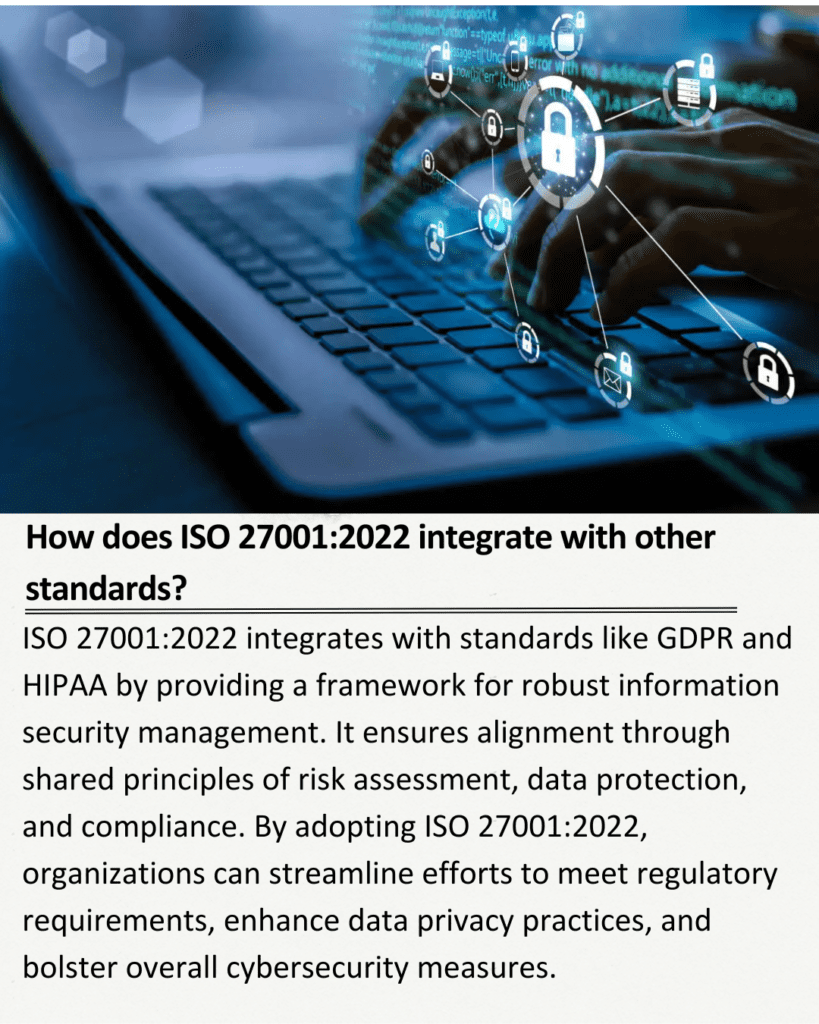Subtotal $0.00

In the landscape of information security management, organizations often face the challenge of navigating multiple regulatory frameworks and standards to ensure comprehensive compliance and effective security practices. ISO 27001:2022, the latest iteration of the international standard for information security management systems (ISMS), plays a pivotal role in this context by providing a structured approach that can be aligned with various other standards, including GDPR (General Data Protection Regulation), HIPAA (Health Insurance Portability and Accountability Act), and others.
Understanding ISO 27001:2022
ISO 27001:2022 emphasizes a risk-based approach to information security, focusing on the confidentiality, integrity, and availability of information assets within an organization. It provides a systematic framework that helps organizations establish, implement, maintain, and continually improve their ISMS. The standard is designed to be adaptable to various sectors and sizes of organizations, making it a flexible tool for managing information security risks.
Integration with GDPR
General Data Protection Regulation (GDPR) is a comprehensive data protection regulation in the European Union (EU) that affects organizations worldwide if they process or handle personal data of EU residents. ISO 27001:2022 and GDPR share several commonalities that facilitate integration:
Data Protection Principles: Both ISO 27001:2022 and GDPR emphasize the importance of protecting personal data. ISO 27001 provides a framework for implementing technical and organizational measures to secure data, which aligns with GDPR’s requirements for data protection.
Risk Management: ISO 27001:2022’s risk-based approach complements GDPR’s requirement for assessing risks to individuals’ rights and freedoms. Organizations can use ISO 27001 to identify and mitigate risks related to data processing activities, thereby enhancing GDPR compliance.
Continuous Improvement: Both standards advocate for continuous improvement of information security and data protection practices. ISO 27001:2022’s PDCA (Plan-Do-Check-Act) cycle encourages organizations to continually monitor, evaluate, and improve their ISMS, aligning with GDPR’s principle of accountability and transparency.
Documentation Requirements: ISO 27001:2022 requires organizations to maintain documentation of their ISMS processes and procedures, including risk assessments and controls. This documentation helps demonstrate compliance with GDPR’s accountability principle, ensuring that organizations can prove their adherence to data protection requirements.
Integration with HIPAA
Health Insurance Portability and Accountability Act (HIPAA) sets forth standards for protecting sensitive patient health information (PHI) in the United States. ISO 27001:2022 integration with HIPAA focuses on:
Security Controls: ISO 27001:2022 provides a comprehensive set of security controls that can be aligned with HIPAA’s requirements for safeguarding PHI. These controls cover areas such as access control, encryption, incident management, and business continuity, which are essential for protecting health information.
Risk Assessment: Both ISO 27001:2022 and HIPAA require organizations to conduct risk assessments to identify threats and vulnerabilities to PHI. ISO 27001’s risk management framework helps organizations prioritize risks and implement appropriate security measures to mitigate them, supporting HIPAA compliance efforts.
Compliance Documentation: ISO 27001:2022’s emphasis on documentation aligns with HIPAA’s requirement for maintaining comprehensive records of security policies, procedures, and compliance efforts. This documentation demonstrates to regulators and stakeholders that the organization has implemented appropriate measures to protect PHI.
Integration with Other Standards
ISO 27001:2022’s compatibility extends beyond GDPR and HIPAA, encompassing a wide range of other standards and regulations, including:
PCI DSS (Payment Card Industry Data Security Standard): ISO 27001 provides a foundation for securing cardholder data and aligning with PCI DSS requirements.
NIST Cybersecurity Framework: Organizations can use ISO 27001:2022 to implement controls aligned with the NIST Cybersecurity Framework, enhancing their cybersecurity posture.
ITIL (Information Technology Infrastructure Library): ISO 27001:2022 supports ITIL’s best practices for managing IT services, ensuring that information security is integrated into service delivery and support processes.
Conclusion
ISO 27001:2022 serves as a cornerstone for organizations seeking to implement robust information security practices while aligning with various regulatory requirements and industry standards. By adopting ISO 27001:2022’s risk-based approach and comprehensive security controls, organizations can enhance their cybersecurity posture, demonstrate compliance with regulations such as GDPR and HIPAA, and build trust with stakeholders. The standard’s flexibility and scalability make it a valuable tool for adapting to evolving regulatory landscapes and emerging cybersecurity threats, ensuring that organizations can effectively protect their information assets while meeting legal and regulatory obligations.
In essence, the integration of ISO 27001:2022 with other standards reinforces its role as a globally recognized framework for achieving effective information security management and regulatory compliance.